ABS YAMAHA XMAX 400 2020 Owners Manual
[x] Cancel search | Manufacturer: YAMAHA, Model Year: 2020, Model line: XMAX 400, Model: YAMAHA XMAX 400 2020Pages: 118, PDF Size: 9.04 MB
Page 1 of 118
![YAMAHA XMAX 400 2020 Owners Manual PANTONE285C
YP400RA
X-MAX 400 ABS
OWNER’S MANUAL
BL1-F8199-E1
MOTORCYCLE
[English (E)]
Read this manual carefully before oper-
ating this vehicle. YAMAHA XMAX 400 2020 Owners Manual PANTONE285C
YP400RA
X-MAX 400 ABS
OWNER’S MANUAL
BL1-F8199-E1
MOTORCYCLE
[English (E)]
Read this manual carefully before oper-
ating this vehicle.](/img/51/52977/w960_52977-0.png)
PANTONE285C
YP400RA
X-MAX 400 ABS
OWNER’S MANUAL
BL1-F8199-E1
MOTORCYCLE
[English (E)]
Read this manual carefully before oper-
ating this vehicle.
Page 5 of 118

Table of contents
Safety information............................1-1
Further safe-riding points ................1-5
Description........................................2-1
Left view ..........................................2-1
Right view........................................2-2
Controls and instruments ................2-3
Smart key system ............................3-1
Smart key system............................3-1
Operating range of the smart key
system .........................................3-2
Handling of the smart key and
mechanical keys ..........................3-3
Smart key ........................................3-5
Replacing the smart key battery .....3-6
Main switch .....................................3-8
Instrument and control functions....4-1
Indicator lights and warning
lights ............................................4-1
Speedometer...................................4-2
Tachometer .....................................4-3
Multi-function display......................4-3
Handlebar switches.......................4-12
Front brake lever ...........................4-13
Rear brake lever ............................4-14
Rear brake lock lever ....................4-14
ABS ...............................................4-15
Traction control system.................4-16
Fuel tank cap.................................4-18
Fuel................................................4-19
Fuel tank overflow hose ................4-20
Catalytic converters .....................4-21
Storage compartments .................4-21
Windshield.....................................4-23
Handlebar position .......................4-26
Adjusting the shock absorber
assemblies .................................4-26
Sidestand ......................................4-27
Ignition circuit cut-off system........4-28
Auxiliary DC jack ..........................4-30For your safety – pre-operation
checks............................................... 5-1
Operation and important riding
points................................................. 6-1
Starting the engine.......................... 6-2
Starting off ...................................... 6-3
Acceleration and deceleration ........ 6-3
Braking............................................ 6-4
Tips for reducing fuel
consumption................................ 6-5
Engine break-in ............................... 6-5
Parking ............................................ 6-6
Periodic maintenance and
adjustment........................................ 7-1
Owner’s tool kit ............................... 7-2
Periodic maintenance chart for the
emission control system.............. 7-3
General maintenance and
lubrication chart........................... 7-4
Removing and installing panels ...... 7-7
Checking the spark plug ................. 7-8
Canister........................................... 7-9
Engine oil and oil filter element ..... 7-10
Final transmission oil .................... 7-12
Coolant ......................................... 7-13
Air filter elements and check
hoses and V-belt case air filter
element ...................................... 7-15
Checking the throttle grip free
play ............................................ 7-17
Valve clearance ............................. 7-18
Tires .............................................. 7-18
Cast wheels .................................. 7-20
Checking the front and rear brake
lever free play ............................ 7-21
Adjusting the rear brake lock
cable .......................................... 7-22
Checking the rear brake lock ........ 7-22
Checking the front and rear brake
pads........................................... 7-23
Checking the brake fluid level....... 7-23
Changing the brake fluid............... 7-24
Checking the V-belt ...................... 7-25
UBL1E0E0.book Page 1 Thursday, May 11, 2017 8:51 AM
Page 12 of 118

Description
2-1
2
EAU63371
Left view
41
5610812791113
23
1. Storage compartment A (page 4-21)
2. Owner’s tool kit (page 7-2)
3. Grab bar (page 6-3)
4. Shock absorber assembly spring preload adjusting ring (page 4-26)
5. Air filter element (left) (page 7-15)
6. Final transmission oil filler cap (page 7-12)
7. Final transmission oil drain bolt (page 7-12)
8. V-belt case air filter element (page 7-15)
9. Engine oil drain bolt (page 7-10)
10.Engine oil filter element (page 7-10)
11.Sidestand (page 4-27)
12.Spark plug (page 7-8)
13.Coolant reservoir (page 7-13)
UBL1E0E0.book Page 1 Thursday, May 11, 2017 8:51 AM
Page 13 of 118
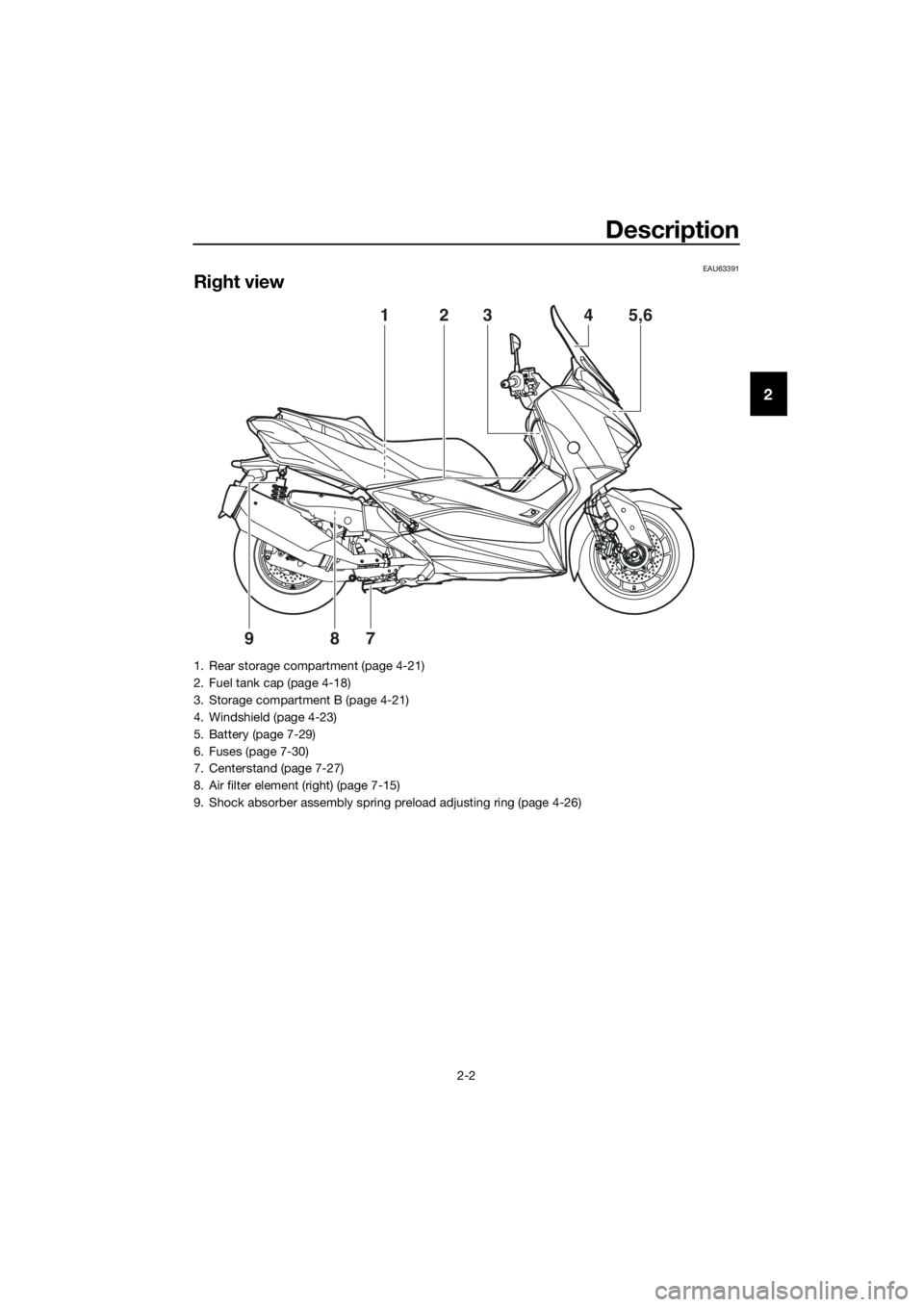
Description
2-2
2
EAU63391
Right view
2345,61
987
1. Rear storage compartment (page 4-21)
2. Fuel tank cap (page 4-18)
3. Storage compartment B (page 4-21)
4. Windshield (page 4-23)
5. Battery (page 7-29)
6. Fuses (page 7-30)
7. Centerstand (page 7-27)
8. Air filter element (right) (page 7-15)
9. Shock absorber assembly spring preload adjusting ring (page 4-26)
UBL1E0E0.book Page 2 Thursday, May 11, 2017 8:51 AM
Page 27 of 118

Instrument and control functions
4-1
4
EAU4939C
Indicator lights and warning
lights
EAU11032Turn signal indicator lights “ ”
and“”
Each indicator light will flash when its
corresponding turn signal lights are
flashing.
EAU11081High beam indicator light “ ”
This indicator light comes on when the
high beam of the headlight is switched
on.
EAU78180Engine trouble warning light “ ”
This warning light comes on if a prob-
lem is detected in the engine or other
vehicle control system. If this occurs,
have a Yamaha dealer check the on-
board diagnostic system.The electrical circuit of the warning
light can be checked by turning the
main switch to “ON”. The warning light
should come on for a few seconds, and
then go off.
If the warning light does not come on
initially when the main switch is turned
to “ON”, or if the warning light remains
on, have a Yamaha dealer check the
vehicle.
EAU78171ABS warning light “ ”
In normal operation, the ABS warning
light comes on when the main switch is
turned to “ON”, and goes off after trav-
eling at a speed of 10 km/h (6 mi/h) or
higher.
If the ABS warning light:
does not come on when the main
switch is turned to “ON”
comes on or flashes while riding
does not go off after traveling at a
speed of 10 km/h (6 mi/h) or high-
er
The ABS may not work correctly. If any
of the above occurs, have a Yamaha
dealer check the system as soon as
possible. (See page 4-15 for an expla-
nation of the ABS.)
WARNING
EWA16041
If the ABS warning light does not go
off after traveling at a speed of 10
km/h (6 mi/h) or higher, or if the
warning light comes on or flashes
while riding, the brake system re-
verts to conventional braking. If ei-
ther of the above occurs, or if the
warning light does not come on at
all, use extra caution to avoid possi-
ble wheel lock during emergency
1. Left turn signal indicator light “ ”
2. Right turn signal indicator light “ ”
3. High beam indicator light “ ”
4. Anti-lock Brake System (ABS) warning
light “ ”
5. Engine trouble warning light “ ”
6. Traction control system indicator light “ ”
7. Smart key system indicator light “ ”
ZAUM1478
12
ABS
ABS
UBL1E0E0.book Page 1 Thursday, May 11, 2017 8:51 AM
Page 28 of 118

Instrument and control functions
4-2
4braking. Have a Yamaha dealer
check the brake system and electri-
cal circuits as soon as possible.
TIP
The ABS warning light may come on
while accelerating the engine with the
vehicle on its centerstand, but this
does not indicate a malfunction.
If this happens, turn the main switch off
and then back on again to reset the in-
dicator light.
EAU78591Traction control system indicator
light “TCS”
This indicator light will flash when trac-
tion control has engaged.
If the traction control system is turned
off, this indicator light will come on.
(See page 4-16.)
TIP
When the vehicle is turned on, the light
should come on for a few seconds and
then go off. If the light does not come
on, or if the light remains on, have a
Yamaha dealer check vehicle.
EAU78600Smart key system indicator
light “ ”
This indicator light communicates the
status of the smart key system. When
the smart key system is operating nor-
mally, this indicator light will be off. If
there is an error in the smart key sys-
tem, the indicator light will flash. The
indicator light will also flash when com-
munication between the vehicle and
smart key takes place and when cer-
tain smart key system operations are
carried out.
EAU63544
Speedometer
For the UK
The speedometer shows the vehicle’s
traveling speed.
When the vehicle power is turned on,
the speedometer needle will sweep
once across the speed range and then
return to zero in order to test the elec-
trical circuit.
1. Speedometer
1. Speedometer
ZAUM1479
1
ZAUM1526
1
UBL1E0E0.book Page 2 Thursday, May 11, 2017 8:51 AM
Page 41 of 118
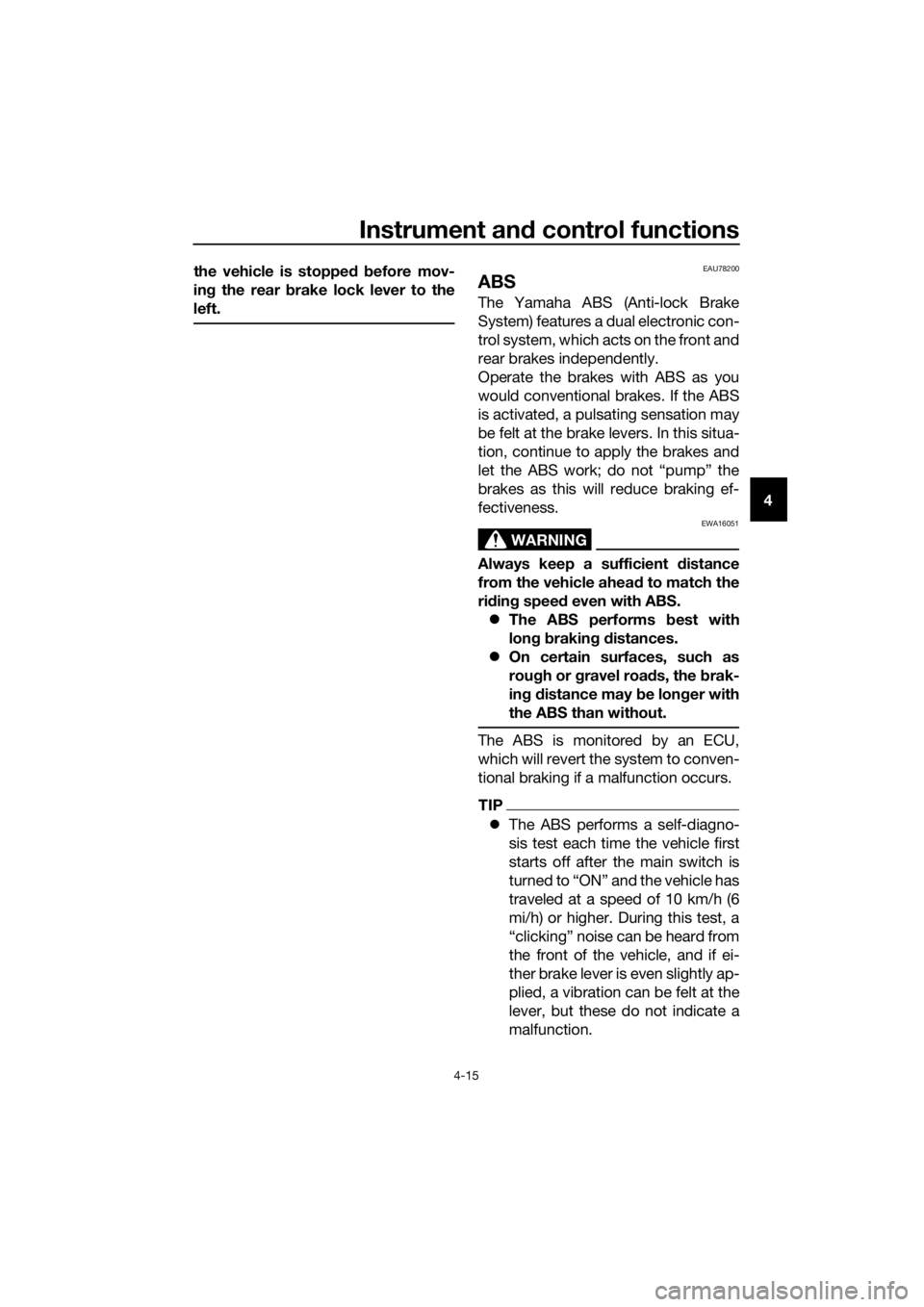
Instrument and control functions
4-15
4 the vehicle is stopped before mov-
ing the rear brake lock lever to the
left.
EAU78200
ABS
The Yamaha ABS (Anti-lock Brake
System) features a dual electronic con-
trol system, which acts on the front and
rear brakes independently.
Operate the brakes with ABS as you
would conventional brakes. If the ABS
is activated, a pulsating sensation may
be felt at the brake levers. In this situa-
tion, continue to apply the brakes and
let the ABS work; do not “pump” the
brakes as this will reduce braking ef-
fectiveness.
WARNING
EWA16051
Always keep a sufficient distance
from the vehicle ahead to match the
riding speed even with ABS.
The ABS performs best with
long braking distances.
On certain surfaces, such as
rough or gravel roads, the brak-
ing distance may be longer with
the ABS than without.
The ABS is monitored by an ECU,
which will revert the system to conven-
tional braking if a malfunction occurs.
TIP
The ABS performs a self-diagno-
sis test each time the vehicle first
starts off after the main switch is
turned to “ON” and the vehicle has
traveled at a speed of 10 km/h (6
mi/h) or higher. During this test, a
“clicking” noise can be heard from
the front of the vehicle, and if ei-
ther brake lever is even slightly ap-
plied, a vibration can be felt at the
lever, but these do not indicate a
malfunction.
UBL1E0E0.book Page 15 Thursday, May 11, 2017 8:51 AM
Page 42 of 118
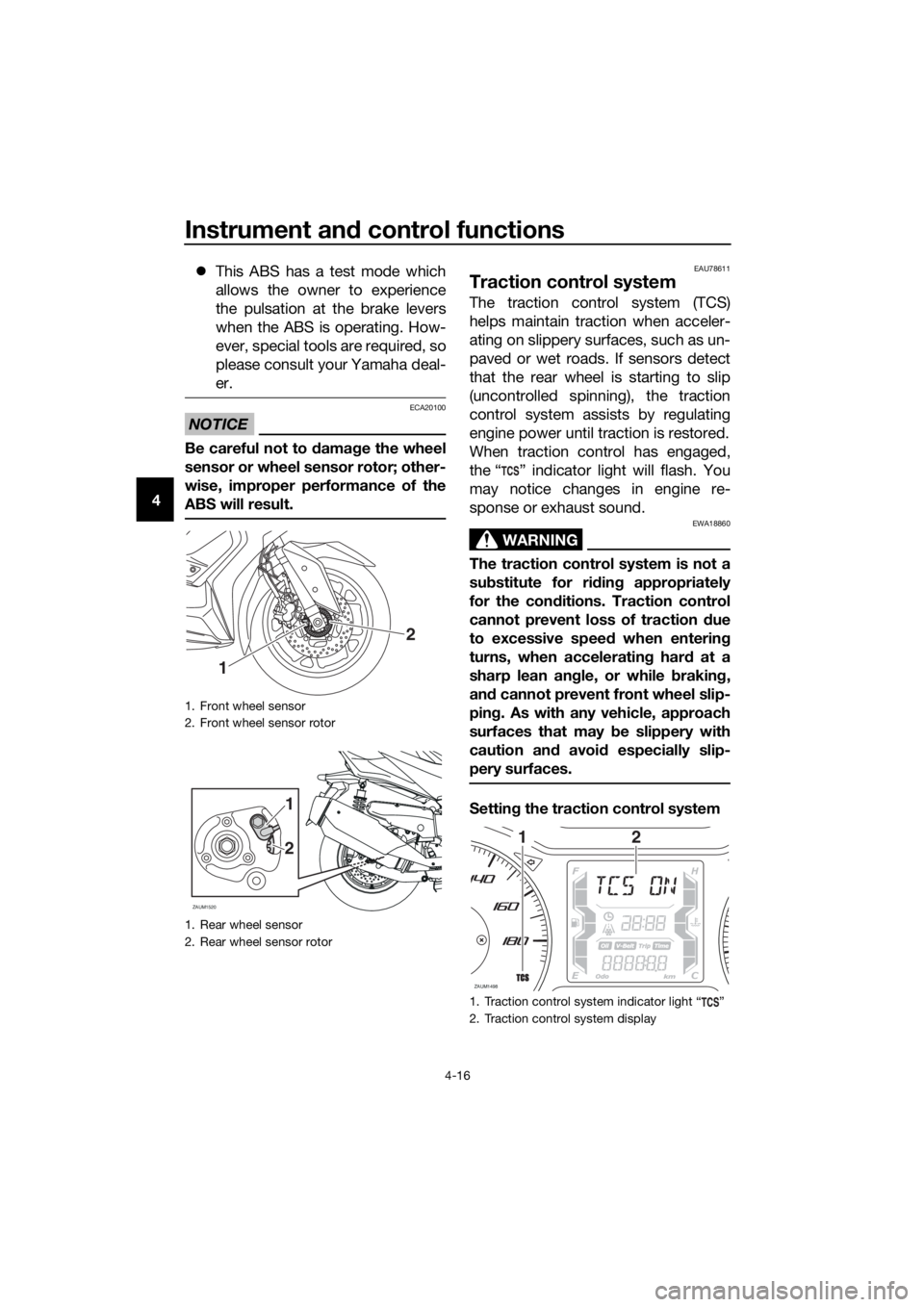
Instrument and control functions
4-16
4This ABS has a test mode which
allows the owner to experience
the pulsation at the brake levers
when the ABS is operating. How-
ever, special tools are required, so
please consult your Yamaha deal-
er.
NOTICE
ECA20100
Be careful not to damage the wheel
sensor or wheel sensor rotor; other-
wise, improper performance of the
ABS will result.
EAU78611
Traction control system
The traction control system (TCS)
helps maintain traction when acceler-
ating on slippery surfaces, such as un-
paved or wet roads. If sensors detect
that the rear wheel is starting to slip
(uncontrolled spinning), the traction
control system assists by regulating
engine power until traction is restored.
When traction control has engaged,
the “ ” indicator light will flash. You
may notice changes in engine re-
sponse or exhaust sound.
WARNING
EWA18860
The traction control system is not a
substitute for riding appropriately
for the conditions. Traction control
cannot prevent loss of traction due
to excessive speed when entering
turns, when accelerating hard at a
sharp lean angle, or while braking,
and cannot prevent front wheel slip-
ping. As with any vehicle, approach
surfaces that may be slippery with
caution and avoid especially slip-
pery surfaces.
Setting the traction control system
1. Front wheel sensor
2. Front wheel sensor rotor
1. Rear wheel sensor
2. Rear wheel sensor rotor
2
1
2
1
ZAUM1520
1. Traction control system indicator light Ž
2. Traction control system display
ZAUM1498
12
UBL1E0E0.book Page 16 Thursday, May 11, 2017 8:51 AM
Page 52 of 118
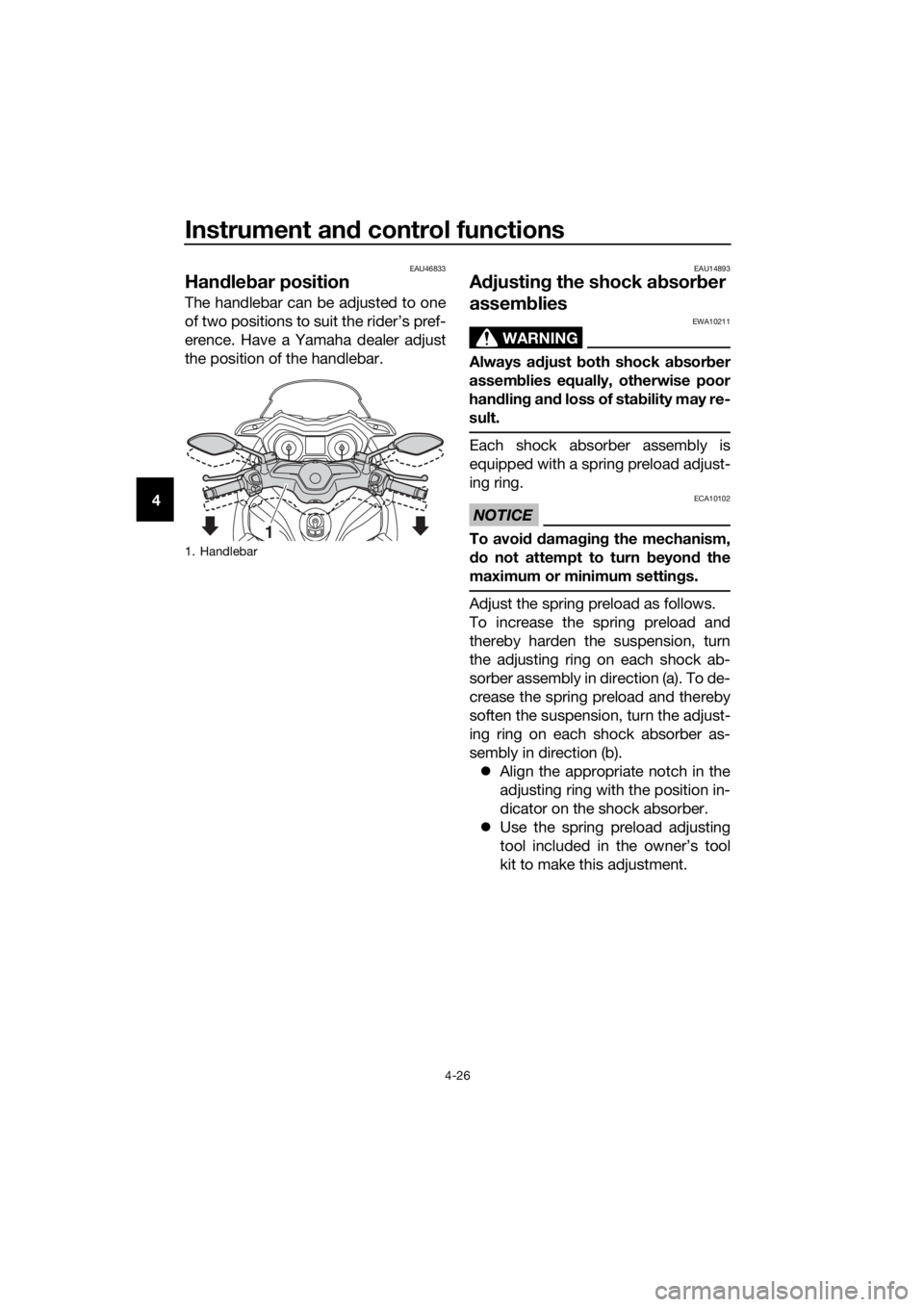
Instrument and control functions
4-26
4
EAU46833
Handlebar position
The handlebar can be adjusted to one
of two positions to suit the rider’s pref-
erence. Have a Yamaha dealer adjust
the position of the handlebar.
EAU14893
Adjusting the shock absorber
assemblies
WARNING
EWA10211
Always adjust both shock absorber
assemblies equally, otherwise poor
handling and loss of stability may re-
sult.
Each shock absorber assembly is
equipped with a spring preload adjust-
ing ring.
NOTICE
ECA10102
To avoid damaging the mechanism,
do not attempt to turn beyond the
maximum or minimum settings.
Adjust the spring preload as follows.
To increase the spring preload and
thereby harden the suspension, turn
the adjusting ring on each shock ab-
sorber assembly in direction (a). To de-
crease the spring preload and thereby
soften the suspension, turn the adjust-
ing ring on each shock absorber as-
sembly in direction (b).
Align the appropriate notch in the
adjusting ring with the position in-
dicator on the shock absorber.
Use the spring preload adjusting
tool included in the owner’s tool
kit to make this adjustment.
1. Handlebar
1
UBL1E0E0.book Page 26 Thursday, May 11, 2017 8:51 AM
Page 60 of 118
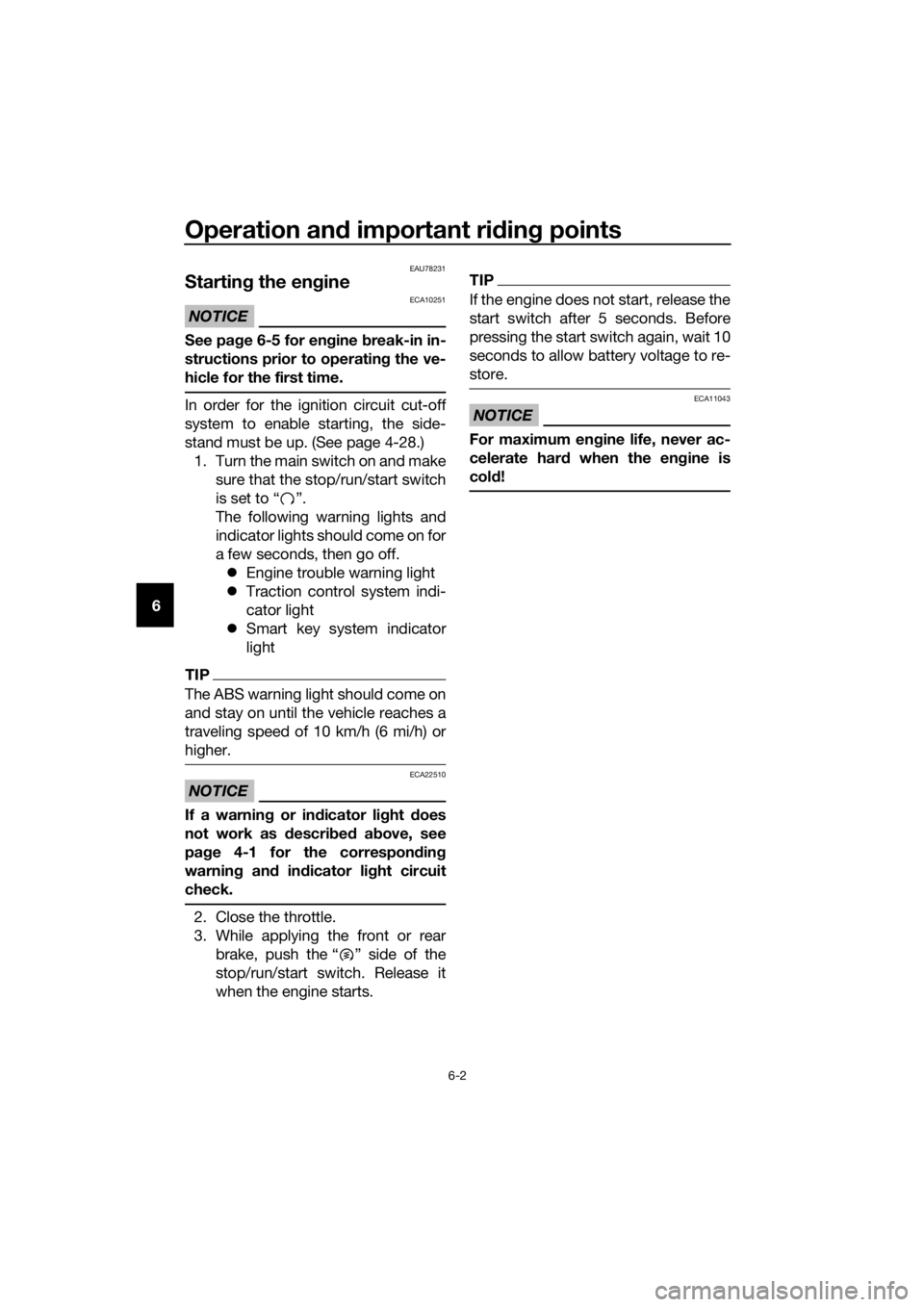
Operation and important riding points
6-2
6
EAU78231
Starting the engine
NOTICE
ECA10251
See page 6-5 for engine break-in in-
structions prior to operating the ve-
hicle for the first time.
In order for the ignition circuit cut-off
system to enable starting, the side-
stand must be up. (See page 4-28.)
1. Turn the main switch on and make
sure that the stop/run/start switch
is set to “ ”.
The following warning lights and
indicator lights should come on for
a few seconds, then go off.
Engine trouble warning light
Traction control system indi-
cator light
Smart key system indicator
light
TIP
The ABS warning light should come on
and stay on until the vehicle reaches a
traveling speed of 10 km/h (6 mi/h) or
higher.
NOTICE
ECA22510
If a warning or indicator light does
not work as described above, see
page 4-1 for the corresponding
warning and indicator light circuit
check.
2. Close the throttle.
3. While applying the front or rear
brake, push the “ ” side of the
stop/run/start switch. Release it
when the engine starts.
TIP
If the engine does not start, release the
start switch after 5 seconds. Before
pressing the start switch again, wait 10
seconds to allow battery voltage to re-
store.
NOTICE
ECA11043
For maximum engine life, never ac-
celerate hard when the engine is
cold!
UBL1E0E0.book Page 2 Thursday, May 11, 2017 8:51 AM